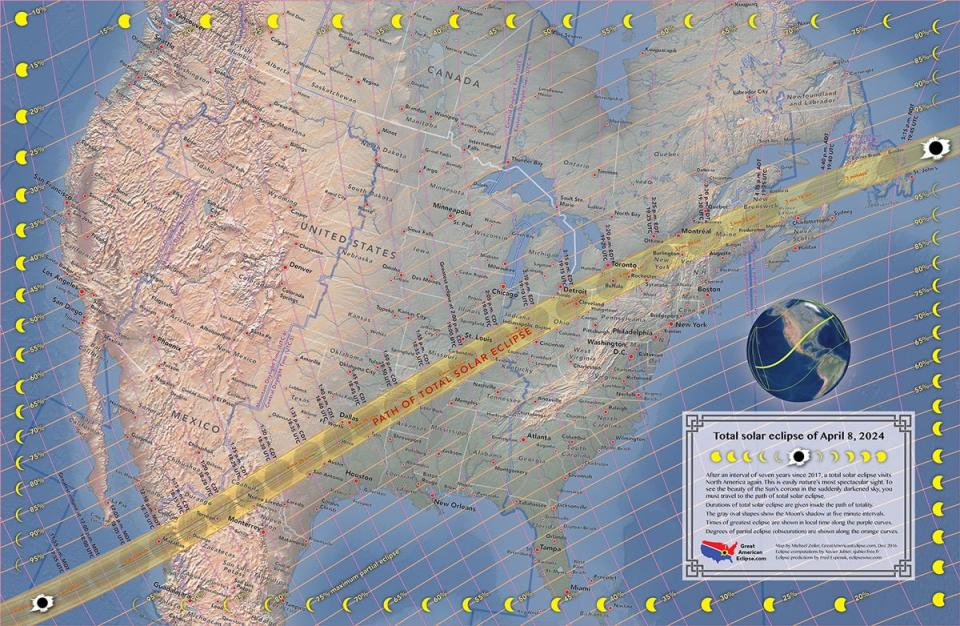Monday’s solar eclipse path of totality may not be exact: What to do if you are on the edge
A new map is projecting that the path of totality for Monday's solar eclipse may be narrower than experts previously believed. But if you're right on the edge of the path, don't go changing your plans just yet.
New amateur calculations suggest that widely-accepted path could be off by as much as just a few hundred yards. The potential shift in the eclipse's path is so miniscule, in fact, that a NASA spokesperson told the Detroit Free Press that the U.S. space agency won't be making any alterations to its own calculations.
So, even if the new calculation is more accurate, it’s unlikely to matter much for most of the millions of skygazers who hope to witness the first total solar eclipse in North America in seven years.
Still, there are some things you should know if you a teetering on the edge of the total eclipse's path.
Don't stop looking up after the eclipse: 3 other celestial events visible in April
NASA is not changing path calculations
The new eclipse calculations come courtesy of John Irwin, a member of the team of amateur astronomers analyzing the celestial event for the Besselian Elements.
According to the group's website, Irwin re-examined the eclipse path with "adjustments that account for the topographic elevation, both around the limb of the moon and on the surface of the Earth." These new calculations have slightly shifted the solar eclipse's path of totality, which may raise some alarms just days before the 115-mile-wide eclipse passes from southwest to northeast over portions of Mexico, the United States and Canada.

If Irwin is correct, some places, including several cities in Ohio, may now miss out on totality, while other places, including some additional cities in Texas, may now experience it.
But don't fret too much: Not only is the new analysis not yet peer-reviewed, but NASA told the Free Press, part of the USA TODAY Network, that its predictions have not changed.
However, NASA spokesman Tiernan Doyle acknowledged "a tiny but real uncertainty about the size of the sun" could lead to a narrower eclipse path.
What does Irwin's new path of totality show?
The red lines shown below represent the original path of totality, while the orange lines show the path updated with Irwin's new data.
While you can click on the embedded map to see the details, Forbes identified 15 areas whose place on the path may have been altered in some form.
Your best bet? Just to be safe, those ardent about witnessing totality should move as far into its projected shadow away from the edges as possible.
"Traveling toward the center of the path of totality, even a mile or two, will quickly increase the length of totality that people can see," Doyle told the Free Press.
What else to know about the April 8 eclipse
Hundreds of cities in 13 states are on the path of totality for this year's total solar eclipse, which for those in the United States, will begin in Eagle Pass, Texas and end in Lee, Maine.

You won't want to miss it, as this is the last such eclipse in North America until 2044.
And don't forget: While a total solar eclipse offers sky-gazers the rare opportunity to witness the display with the naked eye, solar eclipse glasses are still needed until it's safe to do so. Certified solar eclipse glasses are crucial for spectators to avoid the sun's retina-damaging rays.
But when the moon moves completely in front of the sun and blocks its light, you'll know it's safe to remove them for a short period of time.
As you make your eclipse-viewing plans, this guide should help you find some last-minute eclipse glasses, while these interactive maps should help you chart the time and duration for when totality would occur in cities along the path.
Contributing: Mariyam Muhammad, the Cincinnati Enquirer
This article originally appeared on USA TODAY: Solar eclipse path of totality may not be exact: Here's what to know
